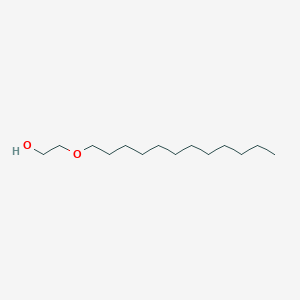| Synonyms |
Click to Show/Hide the Synonyms of This DIG
2-(DODECYLOXY)ETHANOL; Ethylene glycol monododecyl ether; 4536-30-5; Laureth 4; Ethanol, 2-(dodecyloxy)-; aetoxisclerol; atossisclerol; ethoxysclerol; Lauryl ethoxylate; 2-dodecoxyethanol; Laureth-1; Aethoxysklerol; Laureth; Thesit; Lauryl monoethoxylate; Lubrol PX; Laureth 9; Lipocol L-1; Cimagel; Lubrol 12A9; Hydroxypolyethoxydodecane; Slovasol S; Rokanol L; Romopal LN; Nikkol BL; Actinol L3; Aldosperse L 9; Ethylene glycol monolauryl ether; Carsonol L 2; Carsonol L 3; Lauryl alcohol oxy ethanol; Simulsol P 4; Alkasurf LAN 1; Alkasurf LAN 3; Chimipal AE 3; Ethoxylated dodecyl alcohol; polyoxyethylenedodecyl ether; Laureth-11; Actinol L 7; Lauromacrogol 400; Noniolite AL 20; Texofor B 9; 40L (polyether); Adeka Carpol M 2; Ethosperse LA 12; Ethosperse LA 23; Mergital LM 11; Polyoxyethylene lauryl ether; Simulsol P 23; Akyporox RLM 22; Akyporox RLM 40; Dodecanol, ethoxylate; BL 9 (polyglycol); Pegnol L 12; Akyporox RLM 160; Akyporox RLM 230; polyoxyethylene 9-lauryl ether; Adekatol LA 1275; Brij 35; Noigen ET 160; Arapol 0712; Newcol 1203; PEG-11 Lauryl ether; Ethoxylated lauryl alcohol; Adeka Carpol MBF 100; nonaethyleneglycol monododecyl ether; UNII-J89TKQ5R54; dodecyl ethyleneglycol monoether; Laureth 4 [USAN]; Laureth 9 [USAN]; Polyoxyethylene dodecyl mono ether; Dodecyl alcohol polyoxyethylene ether; Ethylene glycol mono-n-dodecyl ether; alpha-Dodecyl-omega-hydroxypoly(oxy-1,2ethanediyl); 2-Hydroxyethyl lauryl ether; Glycols, polyethylene, monododecyl ether; Ethylene glycol dodecyl ether; J89TKQ5R54; alpha-Dodecyl-omega-hydroxypoly(oxyethylene); CHEBI:78770; alpha-Dodecyl-omega-hydroxypoly(oxy-1,2-ethanediyl); MFCD00042657; Poly(oxy-1,2-ethanediyl), alpha-dodecyl-omega-hydroxy-; Laureth 4 (USAN); Laureth 9 (USAN); 2-dodecyloxyethan-1-ol; DSSTox_CID_5218; DSSTox_RID_80389; DSSTox_GSID_44676; Brij 30; Lauromacrogol; Thesat; Surfactant WK; Ethanol,2-(dodecyloxy)-; Siponic L; Standamul LA 2; Calgene 40L; LA (Alcohol); CAS-4536-30-5; Du Pont WK; Lipal 4LA; Marlipal 1217; Chemal LA 23; Conion 2P80; PEG-1 Lauryl ether; Brij 30ICI; Brij 30SP; Brij 35L; Brij 36T; Noigen ET 170; Noigen YX 500; Brij 22; Brij 23; Stmer 135; Polyethylene glycol monolauryl ether; Atlas G 2133; Atlas G 3705; Atlas G 3707; Atlas G 4829; Atlas G-2133; Atlas G-3705; EINECS 224-886-5; Conion 275-20; Conion 275-30; Conion 275-80; Dodecan-1-ol, ethoxylated; Conion 275-100; 2-(dodecyloxy)ethan-1-ol; BRN 1748129; Lauromacrogol 400 [INN]; BASE LP 12; Dodecylglycol; AI3-09524; BL 9; CCRIS 3397; LA 7; polyoxyethylene(23)lauryl ether; HSDB 4351; NCI-C54875; Varithena (TN); Asclera (TN); Polidocanol (JAN); Brij35; Laureth- 23; 2-Dodecyloxy-ethanol; Aethoxysklerol (TN); ACMC-1AEVJ; UNII-0AWH8BFG9A; UNII-BD7AST04GA; UNII-MGU0HEW21Q; B 205; 0AWH8BFG9A; BD7AST04GA; MGU0HEW21Q; bmse000753; Brij 30 (TN); Ethoxylated Lauryl Alcohols; UNII-6SU0SC83AH; UNII-WG3R46N0SV; G 3707; 6SU0SC83AH; POLYOXYL LAURYL ETHER; UNII-002FR4N8OV; UNII-APG12V4K45; UNII-ELB3Y6474W; UNII-KZF7XN8153; UNII-N72LMW566G; UNII-QU7U88D04I; UNII-RPD53041LR; WG3R46N0SV; SCHEMBL77030; 4-01-00-02386 (Beilstein Handbook Reference); UNII-OAH19558U1; 002FR4N8OV; APG12V4K45; ELB3Y6474W; KZF7XN8153; N72LMW566G; QU7U88D04I; RPD53041LR; Polyoxyethylene 23 lauryl ether; CHEMBL1201751; DTXSID8044676; UNII-6HQ855798J; UNII-W9D845551A; UNII-Z95S6G8201; CHEBI:31765; DTXSID10891683; Polyoxyethilene(23) lauryl ether; C12E1; OAH19558U1; ZINC8437287; Tox21_113966; Tox21_301593; ANW-30271; SBB060176; STL452914; AKOS024390811; Dodecyl tricosaoxyethylene glycol ether; 6HQ855798J; FP-0044; MCULE-5043607718; W9D845551A; Z95S6G8201; NCGC00256261-01; NCGC00274074-01; A mixture of monolauryl ethers of polyoxyethylene glycols having a statistical average of 8 ethylene oxide groups per molecule; Polyethylene glycol monododecyl ether, the name is followed by a number (400) corresponding approximately to the average molecular mass of the polyethylene glycol portion; E0264; FT-0722559; ST51046408; D01539; D01993; EC 500-002-6; N-; A-Z-N-; A-Fmoc-L-2,4-diaminobutyric acid; Q377036; SR-01000944887; SR-01000944887-1; Ethylene glycol monododecyl ether, BioXtra, >=99.0% (GC); UNII-3Y76363WPB component SFNALCNOMXIBKG-UHFFFAOYSA-N; UNII-P30F471M6B component SFNALCNOMXIBKG-UHFFFAOYSA-N
|
 click to show the detail info of this DBT
click to show the detail info of this DBT
 click to show the detail info of this DBT
click to show the detail info of this DBT

